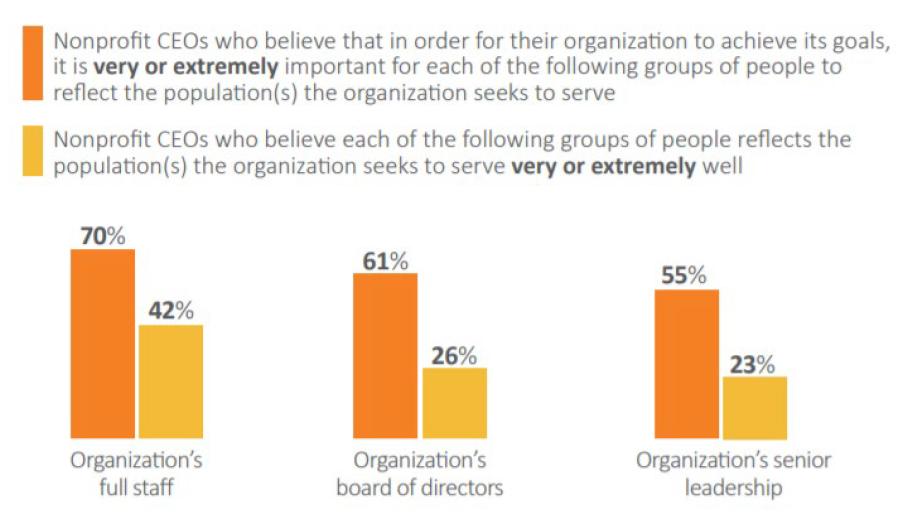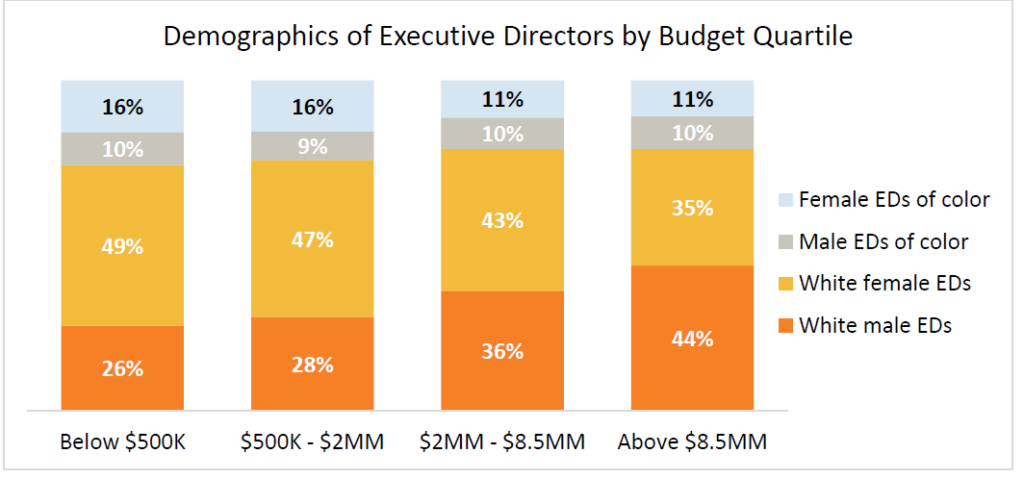Nonprofit CEOs believe that the diversity of their organizations matters, and they recognize that, currently, their staffs and boards should better represent the populations they seek to serve. This is just one of the stark findings that emerged when we surveyed nonprofit CEOs in 2018, around the same time that that Chronicle of Philanthropy published a piece entitled, “After 25 Years of Talk, Are Nonprofits Ready to Act on Diversity?”
Nonprofit CEOs recognize there is a disconnect between the importance of having diverse staff, leadership teams, and boards in order to achieve the organization’s goals, and the reality of how diverse those groups truly are. For example, in our 2018 research, we found that despite 55 percent of nonprofit CEOs believing that it is “very” or “extremely important” for the senior leadership team to reflect the population the organization seeks to serve, only 23 percent believe their senior leadership team reflects the population they seek to serve “very” or “extremely well,” as shown in the chart below. But what’s being done to change this?

Building Movement Project found that over three-quarters of respondents currently working in the nonprofit sector believe that “one of the biggest problems in the nonprofit sector is that leadership of nonprofit organizations doesn’t represent the racial/ethnic diversity of the U.S.”
Similarly, a poll commissioned by The Chronicle of Philanthropy and NYU’s George H. Heyman Jr. Center for Philanthropy and Fundraising found that 44 percent of surveyed women working for large nonprofits believe that their organization “favors males over equally qualified females” for senior leadership positions, even though women make up the majority of nonprofit staffs.
These statistics, and the broader conversation in the sector about who is leading nonprofit organizations, made us want to revisit some key demographic data in our dataset from our Grantee Perception Report (GPR) survey.
Over the course of the past 10 years (2009 – 2019) the GPR has been commissioned by hundreds of foundations. As a part of CEP’s GPR process, when a foundation commissions a GPR, we administer a survey to the person who was the foundation’s main contact at each of the organizations that received a grant within the past fiscal year. In the survey, grantees are asked to provide confidential feedback about their experiences working with that particular foundation.
Executive directors are the biggest respondent group, representing just under half (45 percent) of GPR survey respondents; nearly 30 percent of respondents are senior management team members or project directors, and the remainder are development directors, other staff, or volunteers. In this post, we’ve focused our analysis on U.S. executive directors only, for which we have about 15,000 respondents in our dataset.* Of these executive directors:
- 75% identify as White
- 9% identify as African-American or Black
- 6% identify as Hispanic or Latinx
- 4% identify as Asian (including the Indian subcontinent)
- 3% identify as multiracial
- 1% identify as American Indian or Alaskan Native
- 4% identify as Pacific Islander or Native Hawaiian
- 1% identify as a race/ethnicity not listed above
Almost 60 percent of executive director respondents describe themselves as female.
We do not currently collect data about other elements of diversity for those who respond to the GPR survey.
Because literature like GuideStar’s “2018 Nonprofit Compensation Report” shows that the size of the organization matters when it comes to key demographics of the person in the highest leadership role, we also broke the demographic data down by organization size as defined by budget.
As nonprofit organizational budgets get larger, we see more responses from white male executive directors and fewer responses from female executive directors. For the smallest organizations in our dataset (annual budget less than $500K), 26 percent of executive directors describe themselves as white and male, and 64 percent of executive directors describe themselves as female. For the largest organizations in our dataset (annual budget above $8.5MM), 44 percent of executive directors describe themselves as white and male, and 46 percent of executive directors describe themselves as female, as shown below. (Analysis note: While the increase in white male executive directors and the decrease in female executive directors are statistically significant changes, they are both only of a small effect size, meaning the differences are slight, or small, in magnitude.)

Are white executive directors and executive directors of color having different experiences with their foundation funders? Are male and female executive directors having difference experiences? We examined 48 variables in our GPR survey to answer these questions. A pattern of small differences in ratings by race/ethnicity emerged when it comes to two topics:
- Ratings of funders’ understanding of the local community, context in which the nonprofit works, and ultimate beneficiaries’ needs
- Ratings of strength of relationships between funder and grantee.
For both of these topics, on average, white executive directors provided higher ratings than executive directors of color. (Analysis note: While these differences in ratings are statistically significant, they are both only of a small effect size, meaning the differences are slight, or small, in magnitude.) In line with this data, Building Movement Project’s “Nonprofit Executives and the Racial Leadership Gap: A Race to Lead Brief” found that executive directors of color were more likely to report challenges developing relationships with funding sources.
What should foundation leaders do with this data? Here are some suggestions:
- Collect demographic data about the leadership of organizations your foundation funds. CEP found that although 88 percent of nonprofit CEOs say their foundation funders request demographic information from them about the populations their organization seeks to serve, only 31 percent say their foundation funders have requested demographic information about the leader of the nonprofit being funded.
To support collection of this data, CEP is adding an item to the GPR to ask grantee organizations whether or not they are led by a person of color. While GPR data from grantees is confidential and only reported back to foundations in aggregate – meaning a foundation will never know an individual grantee’s responses to the GPR – this will give foundations a sense of the demographics of those leading the organizations they fund.
- Support the success of leaders of color and efforts to diversify nonprofit leadership, especially at larger organizations. Take steps to understand whether leaders of color are having a less positive experience with your foundation and address those differences.
For example, Fund the People’s 2019 “Talent Justice” report found that executive directors of color are more likely than their white counterparts to state that foundations take a “wait-and-see” approach to funding—a practice during executive transitions in which foundations wait to fund an organization until they see that the incoming executive performs well. This can hinder successful executive transitions. Because the Building Movement Project’s research on nonprofit executives showed that nonprofits led by executive directors of color tend to have smaller budgets and rely more heavily on foundation funding than those led by white executive directors, this practice may especially damage relationships with leaders of color and contribute to destabilizing their organizations.
I hope the data I have described here can contribute to a better understanding of the current state of nonprofit leadership at organizations receiving funding from larger foundations, broken down by race and gender, and spur conversations at foundations about how they can better support both women leaders and leaders of color.
*Data reported in this post includes only U.S. executive directors because race/ethnicity is asked only of U.S.-based organizations completing the GPR. In addition, respondents who selected that they preferred not to say or self-identify for the demographic items analyzed in this post were not included due to those sample sizes being too low to analyze as separate groups.
Ellie Buteau is vice president, research, at CEP. Follow her on Twitter at @e_buteau.


